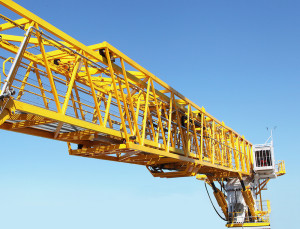SMST Put Telescopic Access Bridge on the Map
SMST has introduced a range of Telescopic Access Bridges (TAB) for the offshore industry. The bridges will facilitate the safe tender of personnel and cargo to and from offshore structures. SMST’s Frederik Maats talks to Offshore Industry’s Ben Littler about breaking a new product onto the market.
The TAB is a natural fit for the Netherlands-based company that delivers a wide range of lifting, transportation, drilling and pipe lay systems and fast offshore craft, for the maritime and offshore industries. All of the company’s products are developed in-house from engineering and design through to construction and installation.
Full Range
The main functions of the TAB range are luffing, slewing and telescoping in order to provide motion compensation. The TAB is designed to be installed on a pedestal and is fixed to the vessel. The system employed is self-stabilising and compensates the vessel motions in order to make offshore access safe during pick up and loading. During normal operations the system can follow the motion of the vessel so power consumption is reduced as far as possible.
SMST has subdivided the range into four categories, S, M, L and XL. The smallest – the S solution – is designed to be installed upon a 13.5m fast offshore craft, which is also part of SMST’s product portfolio. The M, L and XL versions have been designed for both walk to work applications and cargo transfer.
The plan, Mr Maats says, is to market the TAB as a standard product within the range, so that the client simply selects the model that meets their needs. To ensure different requirements are met, the subdivisions are further broken down so that, for example, there are five different categories under the XL division, ranging from 43.5 to 58m maximum length.
Track Record
According to Mr Maats, the demand for the entire range is high, but especially for the larger models. SMST has delivered one 2-XL model (46.5m max), have already started work on the second bridge and has been commissioned for several more.
“The larger sizes are most in demand currently, because of trends in the industry. We’re seeing a lot of projects requiring floating accommodation vessels. Personnel working on such projects need a safe, comfortable way to transfer them from the vessel to either a fixed platform or a floating production unit.”
He goes on to explain that such a bridge requires a very high capacity to cope with the large volumes of personnel crossing it on a regular basis. The TABs, however, can be used to transport much more than just people. They can be used to carry transfer lines for fuel, mud, energy, water and other utilities.
Getting on the Map
The range was unveiled a year ago and so far it is only the larger sizes that have been built, though Mr Maats is confident that the smaller sizes will also prove popular. “We’re getting plenty of enquiries about the smaller sizes as well as the larger ones and we hope to develop these – at the very least in prototype form – over the coming months.”
In the meantime Mr Maats is looking forward to the first of the larger models going into operation. “We hope this puts us on the map with this type of product,” he says. “The first sale of any new line is always a challenge as track record is so import in this industry. However, when that first unit passes into service we will be able to demonstrate what we already know – that this is a first-class product, fully capable of exceeding the high quality and safety standards demanded of it in the offshore industry.”
Visit SMST Designers & Constructions at Offshore Energy at booth nr 11.032








